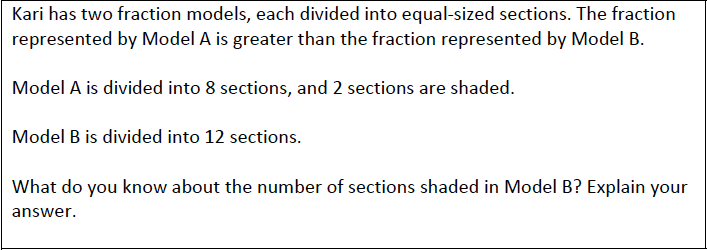Compare two fractions with different numerators and different denominators, e.g., by creating common denominators or numerators, or by comparing to a benchmark fraction such as 1/2. Recognize that comparisons are valid only when the two fractions refer to the same whole. Record the results of comparisons with symbols >, =, or <, and justify the conclusions, e.g., by using a visual fraction model.
[divider] [/divider] Students are able to…
- Use a variety of representations to compare fractions including models, benchmarks, common numerators and common denominators.
- Determine the most efficient strategy for a given comparison and justify their thinking.
[divider] [/divider] Students are able to…because teachers…
- Promote discussion about different students’ strategies for comparing fractions, and ask questions centered around efficiency.
- Provide opportunities for students to justify their reasoning with models, pictures, words, and numbers.
[divider] [/divider] Questions to ask students:
- How could you compare those two fractions using benchmarks?
- Sample answer that indicates understanding: Using the benchmark of 1/2 students should be able to explain that one fraction is less than 1/2, while the other fraction is greater than 1/2, or that one fraction is close to 1/2 while the other is closer to 1 or o. i.e. 1/8 is less than 5/6 because 1/8 is less than 1/2 while 5/6 is greater than 1/2.
- Sample answer that indicates an incomplete understanding or a misconception: Student believes that 1/8 is greater than 5/6 because the denominator of 8 is greater than the denominator of 6)
- Ask students to compare two strategies; using common denominators or benchmark numbers to compare 2/3 and 5/6.
- Sample answer that indicates understanding: I would use common denominators, because it is easy for me to think of 2/3 as 4/6, they are equivalent, and 5/6 is greater than 4/6. I would not use benchmarks because both numbers are greater than 1/2.
- Sample answer that indicates an incomplete understanding or a misconception: It is easier to use common denominators because you just cross multiply, 2 times 6 is 12 and 3 times 5 is 15 so 15 is greater.
- Could you solve that problem using a different strategy? Which strategy is most efficient?
- Sample answer that indicates understanding: The students is able to choose an alternate strategy and justify which strategy is most efficient.
- Sample answer that indicates an incomplete understanding or misconception: Student cannot choose another strategy or is unable to identify which strategy is the most efficient.
[divider] [/divider] FSA Notes
Cognitive Complexity Level: 2: Basic Application of Skills & Concepts
Achievement Level Descriptors:
2- uses visual fraction model to compare two fractions with different numerators and different denominators (2, 3, 4, 6, and 8), using <, >, and =, with the understanding that the fractions must refer to the same whole
3- compares two fractions with different numerators and different denominators, using visual fraction models and <, >, and =
4- compares two fractions with different numerators and different denominators, using <, >, and =; justifies answers
5- [intentionally left blank]
Assessment Limits:
Denominators of given fractions are limited to: 2, 3, 4, 5, 6, 8, 10, 12, 100.
Fractions may be fractions greater than 1 and students may not be guided to put fractions in lowest terms or to simplify.
Two fractions being compared must have both different numerator and different denominator.
[divider] [/divider] Additional Resources:
Additional in depth content knowledge
Video: Using common denominators to compare fractions
using benchmarks to compare fractions
[divider] [/divider] Sample Formative Assessment Tasks:
[divider] [/divider]Resources/Tasks to Support Your Child at Home
Recipes are great real-life opportunities to practice exploring equivalent fractions and strategies for comparing fractions with your child. Encourage your child to find equivalent fractions for recipe ingredients. If a recipe calls for 14 cup sugar, you can ask what the equivalent amount of the 18cup measuring cup of sugar would be. Your child can compare the fractional amount of ingredients required to make a recipe.
Play Tug Team Fractions, a comparing fractions tug-a-war game. http://www.mathplayground.com/ASB_TugTeamFractions.html
Khan Academy “Comparing Fractions with Unlike Denominators” – https://goo.gl/MPNuov
LearnZillion “Compare Fractions Using ½ Benchmark” – https://goo.gl/Hn8yFD
Learnzillion “Compare fractions…” https://goo.gl/9dKc5U


